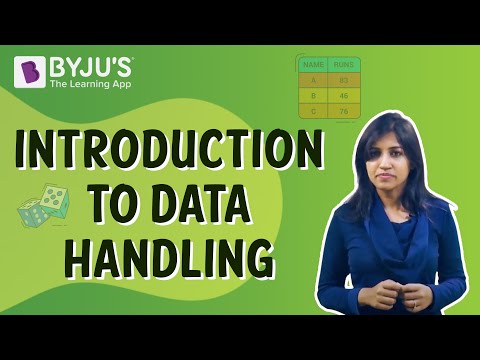Data handling is the method of performing statistical analysis on the given data. What is Data? Why do we need it? Data are individual pieces of information, information about a particular system. The average human body temperature is 37oC, which is data. The number of students in your class is also data. Data is made useful by data collection, data organization and it is finally processed through data analysis. Data handling is the process that comprises of data collection, data organization, data analysis and finally its depiction with the help of graphs or charts.
Data handling comes extremely naturally to us. When someone asks you how old you are, you give them a number, correct. Do you know you just handled data! Your age is a data, your height is a data and your roll number are all data! You are basically handling data already! When I said data handling comes naturally to us, I forgot to mention that some of us are better at handling data than others. I myself was never good at remembering birthdays and numbers, but if you are; then congratulations guys, you already must be pretty good at it! Now every single person in the world is constantly interacting and generating data; your mails, you messages all contain data in large quantities. The industry uses the process of data analysis to make such large amounts of data useful to us.
Data handling Definition
The temperature of the surface of the sun is 5000oC. So how does this data help you? This data is useful when we think about the 5000oC and realize that this means that the surface of the sun is very hot! The data that the sun’s temperature is 5000oC becomes information when it leads to a realization that the sun is very hot. Information is the interpretation and understanding of data.
What you handle day to day is called Raw Data, this kind of data by itself does not have any meaning. Let’s take any test you may have recently had at your school. You have a fixed and known numbered students in your class. The marks that you get is the data here. You can see that your marks by themselves don’t mean much to anyone but you right? If I wanted to know how your class performed in the test then just your data is no good. Its only when the data is organized and processed that it is useful to us. Say for example, the teacher who took your test instead of putting your names alongside the results put it randomly. Would it make any sense to you? What would you do if you wanted to know your scores? So the randomly arranged marks is exactly how data is available to us. It’s only after its organized and structured properly that it is of any use or meaning to us.
For More Information On Data Handling, Watch The Below Video:

Collection of Data
More important than organizing data is the need to know what the data is being collected for. Suppose that you want to find out the marks your friend has gotten in a test. So you go to your teacher and ask to have a look at his paper but your teacher says that he cannot give you the answer sheet and can only tell you the marks. So your teacher tell you the marks in the subject and you note these marks down and go to your friend. On your way you suddenly notice that your friend has scored exactly the same marks as you. A coincidence? What happened here was that the teacher told you your own marks assuming that you were there to check your marks. So the entire data you have just collected is wrong. Even though you have a list of marks with you, it is not the data you initially set out to collect. In data handling, it is extremely important to know what the same data is being collected for before collecting it.
Organization of Data
Earlier it was mentioned that for data to be useful to us, it has to be presented in a organized and a contextual manner! So the importance of organization of data cannot be understated!
You must have seen the old yellow pages. They were these huge books that used to contain the name and number of every resident of a particular city. Even if it was a huge city! So that book contained the names and numbers of thousands of people. So if you go to a city you’ve never been to before and you want to meet your friend who you know lives there, then all you need to do is flip through the yellow pages and you’ll find his name and number there! What a life saver if you get lost isn’t it?
To make such a book, you need a lot of numbers from a lot of people don’t you? Receiving numbers is the easy bit. If you send a bunch of people around the town enquiring for people’s phone numbers, soon enough you will have a considerable amount of data. For this data to be useful, it will have to be arranged in a manner that aids searching. In yellow pages, the names are arranged alphabetically which means if you have a name, you can easily look for it just like you would in a dictionary. Now imagine if the numbers were arranged randomly. How would you search for a particular name in this mess? All the way from A to Z!
Data handling begins with the collection of data followed by the organization of data which leads to the data becoming a useful piece of information. To, learn more about data handling and data analysis with articles on CBSE Mathematics, download BYJU’S – The Learning App.

Comments